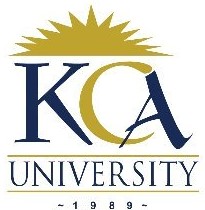
UNIVERSITY EXAMINATIONS: 2018/2019
EXAMINATION FOR THE DEGREES OF BACHELOR OF SCIENCE IN
INFORMATION TECHNOLOGY/ SOFTWARE DEVELOPMENT/
BUSINESS IT/ INFO. SEC& FORENSICS/ APPLIED COMPUTING
BAC 1102/ BISF 1102/ BSD 1105/ BIT 1106/ BBIT 108: OPERATING
SYSTEMS
FULLTIME/ PART TIME/DISTANCE LEARNING
ORDINARY EXAMINATIONS
DATE: DECEMBER, 2018 TIME: 2 HOURS
INSTRUCTIONS: Answer Question One & ANY OTHER TWO questions.
QUESTION ONE [30 MARKS]
a) Operating systems design starts by defining goals and specifications. Briefly describe
THREE objectives of modern operating systems design. (3 Marks)
b) Give any FOUR functions performed by an operating system (4 Marks)
c) Describe the following operating system categories and offer examples:
i) Embedded operating system (2 Marks)
ii) Stand-alone operating system (2 Marks)
iii) Network operating system (2 Marks)
d) Differentiate between uniprogramming and multiprogramming and draw a diagram to
illustrate each. (6 Marks)
e) Describe FOUR cases in which CPU scheduling can happen. (4 Marks)
f) Describe FOUR factors that are considered when deciding a good scheduling algorithm.
(4 Marks)
g) Briefly explain how context switching occurs in operating systems (3 Marks)
QUESTION TWO [20 Marks]
a) Explain in detail how the operating system acts as a user-computer interface. (5 Marks)
b) Utilities are specialized programs that make computing easier. Describe any FOUR
Windows utilities (4 Marks)
c) i) What is the difference between a program and a process? (2 Marks)
ii) The operating system is responsible for several activities in connection with process
management. Describe any FOUR of these activities (4 Marks)
d) A process goes through a series of discrete process states. State and explain FIVE states in
which it can occur. (5 Marks)
QUESTION THREE [20 Marks]
a) Explain the following terms:
i) Job control language (2 Marks)
ii) Distributed computing (2 Marks)
iii) Multi-threaded process (2 Marks)
iv) Race condition (2 Marks)
b) Distinguish between non-preemptive scheduling and preemptive scheduling and give TWO
examples from each (6 Marks)
c) Describe any THREE operating systems security threats and offer ONE example for each
threat. (6 Marks)
QUESTION FOUR [20 Marks]
a) Briefly explain the meaning of the term ‘file system’ (2 Marks)
b) In file naming what do the following file extensions stand for? (5 Marks)
i) File.mp3
ii) File.html
iii) File.txt
iv) File.zip
v) File.jpg
c) i) Explain the concept of operating system security (2 Marks)
ii) Briefly describe the any THREE operating system security goals (3 Marks)
d) State and explain any FOUR layers of I/O software. (8 Marks)
QUESTION FIVE [20 Marks]
a) Computer Software can roughly be divided into TWO forms: system programs and
application programs. Briefly discuss these two categories. (4 Marks)
b) Briefly explain the meaning of the following concepts in the context of operating systems:
i) Virtual memory (2 Marks)
ii) Shell (2 Marks)
iii) Drivers (2 Marks)
c) State and explain TWO types of file access methods. (4 Marks)
d) Discuss any THREE page replacement algorithms in memory management (6 Marks)
